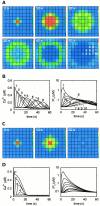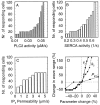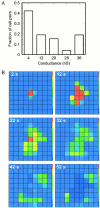Control and plasticity of intercellular calcium waves in astrocytes: a modeling approach
- PMID: 12077182
- PMCID: PMC6757753
- DOI: 10.1523/JNEUROSCI.22-12-04850.2002
Control and plasticity of intercellular calcium waves in astrocytes: a modeling approach
Abstract
Intercellular Ca2+ waves in astrocytes are thought to serve as a pathway of long-range signaling. The waves can propagate by the diffusion of molecules through gap junctions and across the extracellular space. In rat striatal astrocytes, the gap-junctional route was shown to be dominant. To analyze the interplay of the processes involved in wave propagation, a mathematical model of this system has been developed. The kinetic description of Ca2+ signaling within a single cell accounts for inositol 1,4,5-trisphosphate (IP3) generation, including its activation by cytoplasmic Ca2+, IP3-induced Ca2+ liberation from intracellular stores and various other Ca2+ transports, and cytoplasmic diffusion of IP3 and Ca2+. When cells are coupled by gap junction channels in a two-dimensional array, IP3 generation in one cell triggers Ca2+ waves propagating across some tens of cells. The spatial range of wave propagation is limited, yet depends sensitively on the Ca2+-mediated regeneration of the IP3 signal. Accordingly, the term "limited regenerative signaling" is proposed. The gap-junctional permeability for IP3 is the crucial permissive factor for wave propagation, and heterogeneity of gap-junctional coupling yields preferential pathways of wave propagation. Processes involved in both signal initiation (activation of IP3 production caused by receptor agonist) and regeneration (activation of IP3 production by Ca2+, loading of the Ca2+ stores) are found to exert the main control on the wave range. The refractory period of signaling strongly depends on the refilling kinetics of the Ca2+ stores. Thus the model identifies multiple steps that may be involved in the regulation of this intercellular signaling pathway.
Figures








Similar articles
-
Intercellular Ca2+ wave propagation through gap-junctional Ca2+ diffusion: a theoretical study.Biophys J. 2001 Jan;80(1):75-87. doi: 10.1016/S0006-3495(01)75996-6. Biophys J. 2001. PMID: 11159384 Free PMC article.
-
Inositol-trisphosphate-dependent intercellular calcium signaling in and between astrocytes and endothelial cells.Glia. 1998 Dec;24(4):398-407. Glia. 1998. PMID: 9814820
-
Intercellular calcium signaling and gap junctional communication in astrocytes.Glia. 1998 Sep;24(1):50-64. Glia. 1998. PMID: 9700489 Review.
-
Roles of Ca2+, inositol trisphosphate and cyclic ADP-ribose in mediating intercellular Ca2+ signaling in sheep lens cells.J Cell Sci. 1998 May;111 ( Pt 9):1217-25. doi: 10.1242/jcs.111.9.1217. J Cell Sci. 1998. PMID: 9547298
-
Intercellular calcium waves mediated by inositol trisphosphate.Ciba Found Symp. 1995;188:175-89; discussion 189-94. Ciba Found Symp. 1995. PMID: 7587616 Review.
Cited by
-
A mathematical model of the tripartite synapse: astrocyte-induced synaptic plasticity.J Biol Phys. 2012 Jun;38(3):465-96. doi: 10.1007/s10867-012-9267-7. Epub 2012 May 27. J Biol Phys. 2012. PMID: 23729909 Free PMC article.
-
Gap junctional signaling in pattern regulation: Physiological network connectivity instructs growth and form.Dev Neurobiol. 2017 May;77(5):643-673. doi: 10.1002/dneu.22405. Epub 2016 Jun 24. Dev Neurobiol. 2017. PMID: 27265625 Free PMC article. Review.
-
Nonlinear gap junctions enable long-distance propagation of pulsating calcium waves in astrocyte networks.PLoS Comput Biol. 2010 Aug 26;6(8):e1000909. doi: 10.1371/journal.pcbi.1000909. PLoS Comput Biol. 2010. PMID: 20865153 Free PMC article.
-
A kinetic model for calcium dynamics in RAW 264.7 cells: 1. Mechanisms, parameters, and subpopulational variability.Biophys J. 2007 Aug 1;93(3):709-28. doi: 10.1529/biophysj.106.097469. Epub 2007 May 4. Biophys J. 2007. PMID: 17483174 Free PMC article.
-
Connexins in Astrocyte Migration.Front Pharmacol. 2020 Jan 15;10:1546. doi: 10.3389/fphar.2019.01546. eCollection 2019. Front Pharmacol. 2020. PMID: 32009957 Free PMC article. Review.
References
-
- Araque A, Parpura V, Sanzgiri RP, Haydon PG. Tripartite synapses: glia, the unacknowledged partner. Trends Neurosci. 1999;22:208–215. - PubMed
-
- Bezprozvanny I, Watras J, Ehrlich BE. Bell-shaped calcium response curves of Ins(1, 4, 5)P3 and calcium gated channels from endoplasmic reticulum of the cerebellum. Nature. 1991;351:751–754. - PubMed
-
- Blomstrand F, Giaume C, Hansson E, Ronnback L. Distinct pharmacological properties of ET-1 and ET-3 on astroglial gap junctions and Ca2+ signaling. Am J Physiol. 1999;277:C616–627. - PubMed
-
- Braet K, Paemeleire K, D'Herde K, Sanderson MJ, Leybaert L. Astrocyte-endothelial cell calcium signals conveyed by two signalling pathways. Eur J Neurosci. 2001;13:79–91. - PubMed
Publication types
MeSH terms
Substances
LinkOut - more resources
Full Text Sources
Miscellaneous
